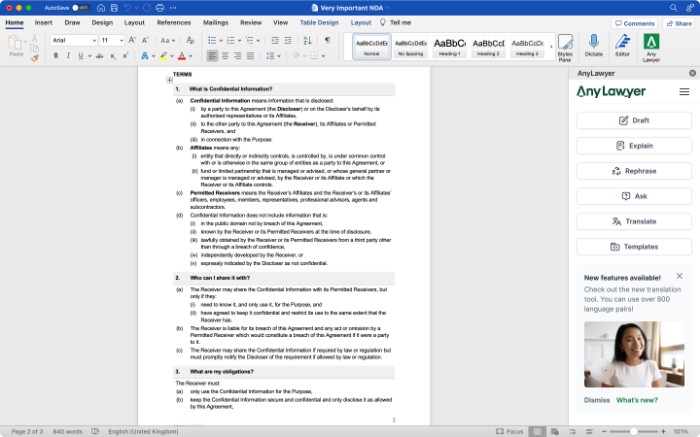Understanding the contract review process and having access to a comprehensive contract review checklist is essential for any lawyer - or anyone working in the legal space - but it can be tricky to determine what is actually needed, or how to go about creating one.
With a comprehensive contract review checklist, legal professionals will have the knowledge and tools necessary to verify each step of the process with ease and accuracy. From understanding what contract review entails to avoiding common mistakes, a checklist should ensure each term is met, every detail is considered, and no stone is left unturned.
What is contract review?
Contract review is the process of reviewing an agreement or contract before it is signed. The aim of a contract review is to ensure that all terms are fair and valid, as well as verifying that each person involved in the agreement understands their responsibilities and obligations.
Thorough contract reviews can often be complex and time consuming, so having an organized checklist will help simplify the process and ensure that everything is accurate.
What does the contract review process look like?
Usually, the contract review process involves a lawyer reading each line of the entire contract to search for potential loopholes, discrepancies, unfair terms, and the like. It is an in-depth analysis that takes into consideration each line in the context of the entire document as well as applicable regulations.
The process can be divided into three major steps:
- Understanding contract terms and evaluating their impact on the parties,
- Making sure that the document is legally valid,
- Assessing risk.
The process of contract review can occur in stages. First, the lawyer or legal professional will read through and analyze the document. Next, they will discuss any changes with those involved in the agreement to ensure that everyone is clear on their obligations. After every contract review stage is completed, a contract review checklist can be followed to make sure that no detail has been overlooked.
Finally, the contract review process will culminate in a signed agreement.
If contract review is part of negotiations, the process may include further rounds of discussions and reviews, depending on the complexity of the deal. Having a comprehensive contract review checklist will help streamline this process by ensuring that all relevant details are addressed and considered.
Roles in the contract review process
A thorough contract review process typically involves several people, all of whom need to have certain competencies and tasks. Usually, it is the responsibility of the lawyer - or legal team - to identify and address any potential issues with a legal agreement, as well as communicating changes or questions back to the client.
Additionally, there should be someone who can provide technical support, such as a paralegal or legal assistant. The team should also include someone who can anticipate any legal risks or compliance issues that may arise during the review process.
Legal team
Legal professionals participating in the contract review process should have a good understanding of contract law, company policies, and industry regulations. A contract review lawyer needs to be able to effectively communicate with the client and other parties involved in the agreement. Their role is to identify and address any issues with the contract, as well as providing technical support and risk assessment.
Paralegals
Paralegals typically provide assistance to lawyers by researching legal matters, gathering evidence, drafting documents, and communicating with other parties involved in the agreement. They should have a good working knowledge of legal terminology and how it applies to the agreement at hand.
Technical support
Some contracts require technical support in order to be accurately reviewed. This may include auditing financial documents, due diligence, or any other research that needs to be done in order to ensure the accuracy and legality of the contract. Having qualified personnel on hand who can provide this kind of assistance is essential in order to have a successful contract review process.
Sales team
The sales team may also be involved in the contract review process. This is particularly true when there are negotiations involved, as they will need to manage ironing out a deal with the client. They should have a good understanding of business and finance to effectively negotiate with other parties.
What is a contract review checklist?
A contract review checklist is a tool used to ensure that all of the necessary information is included in any agreement before it is signed. It is an important element of the due diligence process. The checklist should include each step involved in the document’s review, as well as detailed instructions for addressing any issues that could arise during the process.
Why is a contract review checklist needed?
A contract review checklist is necessary in order to ensure that the entire process runs smoothly and efficiently. It helps organize all of the details and tasks that need to be addressed, as well as keeping track of any changes or updates that have been made to the agreement. Additionally, it can serve as a reference point for those involved in the review process, helping ensure that all relevant information is considered before an agreement is signed.
Using a contract review checklist also has benefits when it comes to accuracy. By having a comprehensive list of all items that need to be addressed, no detail is left unchecked and there is less risk of errors or missing information.
The benefits of a contract review checklist
- An easy way to locate and remove common loopholes, discrepancies, and unfair terms,
- A comprehensive overview of the contract review process,
- A reference point for those involved in the process to ensure all details are addressed,
- An organized system for tracking changes or updates to an agreement,
- Increased accuracy and fewer errors due to oversight,
- A tool for conducting due diligence,
- Reduced risk of costly legal disputes.
What should be included in the contract review checklist?
The contract review checklist should include any essential details related to the agreement, such as deadlines, terms, conditions, and responsibilities of each party. Additionally, the checklist should include any specific provisions or requirements that are necessary for the agreement to be valid and enforceable. It should also cover any legal risks or compliance issues that may need to be addressed before signing.
The checklist should be comprehensive in order to protect all parties involved from any potential legal issues.
Review of terms and clauses
This section should include detailed instructions on how to identify any potential issues or discrepancies in terms and clauses, as well as how to address them. The checklist should also provide guidance on any changes that may need to be made in order for the agreement to meet industry standards or comply with applicable laws.
Terminology
This section should include instructions on how to ensure that all terminology used in the contract is clear and unambiguous. This can help reduce the risk of legal disputes or challenges based on misunderstandings of certain terms or phrases.
Default terms and regulations
This section should cover the review of any default terms that are included in the agreement. This will help ensure that all parties are aware of any potential liabilities or restrictions before signing.
Signatories and witnesses
The checklist should include a list of who needs to sign the contract, as well as details on any witnesses that may be required. Additionally, any steps to take prior to signing should also be included.
Termination and renewal
This section should include information on any specific termination or renewal provisions that are included in the agreement, as well as detailed instructions on how to address them. This includes information on any applicable notice periods and any other considerations that need to be taken into account.
Deadlines
This section should include any applicable deadlines for both parties, as well as a description of the consequences of failing to meet such deadlines.
Risk and compliance
This section should include a review of any potential legal risks or compliance issues that may arise as a result of the agreement. This will help ensure that all parties are aware of any obligations they may have under the contract.
Proofreading
This section should provide instructions on how to review the agreement for typos, formatting errors, and any other possible discrepancies that can affect the validity of a contract. Additionally, it is important to remember that an incomplete contract may lead to unforeseen negative consequences, so the entire document should be carefully checked for blank spaces.
Attachments
This section should cover the review of any attachments that may be included in the agreement, such as invoices or proof of delivery.
A full contract review checklist
This contract checklist template should provide a comprehensive overview of all essential details that need to be addressed before signing an agreement.
Step 1: Review of terms and clauses
- Ensure that the agreement is not ambiguous or open to interpretation.
- Check for potential omissions and discrepancies.
- Identify any areas where additional clarifications may be needed.
- Ensure that previous verbal agreements are reflected in the contract.
- Check terms and conditions.
- Check the indemnification (liability) clause.
- Check the dispute resolution clause.
- Check the confidentiality clause.
- Check the remedies and recourse provisions.
- Make sure there is a course of action for the event of a contract breach.
Step 2: Terminology
- Ensure all terminology used in the contract is clear and unambiguous.
- Review any technical terms and make sure they are defined correctly.
- Check for any inconsistencies in the definitions of terms used throughout the contract.
- Discuss potentially confusing or misleading wording with other parties.
Step 3: Default terms and regulations
- Review all default clauses and terms included in the agreement to ensure that all parties are aware of any potential liabilities or restrictions before signing.
Step 4: Signatories and witnesses
- Ensure that all signatories are authorized to enter into the agreement.
- Confirm any necessary witness requirements.
Step 5: Termination and renewal
- Review any specific termination or renewal terms and provisions that are included in the agreement.
- Ensure that any applicable notice period requirements are addressed.
- Pay attention to automatic renewal language.
- Pay attention to opt-out windows.
Step 6: Deadlines
- Ensure that all applicable deadlines are included in the agreement and that they are reasonable.
- Identify any potential consequences of failing to meet such deadlines.
- Ensure there is a procedure to follow in case the schedule has to change.
- Begin tracking significant deadlines.
Step 7: Risk and compliance
- Review any potential legal risks or compliance issues that may arise as a result of the agreement.
- Confirm whether all parties are aware of, and compliant with, their obligations under the contract.
- Confirm whether risk has been allocated fairly between the parties.
Step 8: Proofreading
- Check for any errors, omissions, typos, or information about the parties that might have changed over the course of contract negotiations.
- Make sure there are no blank spaces left in the final contract.
Step 9: Attachments
- Check that any attachments are present and up to date.
- Review the contents of each attachment to make sure they conform to what is mentioned in the contract.
Key elements determining the validity of a contract
Several conditions that must be met for a contract to be seen as a legally binding agreement.
- Authority of the parties: The parties must have legal capacity to enter into an agreement.
- Offer and acceptance: There must be a valid offer made by one party and accepted by another.
- Consideration: Each party must provide something in return for the other's performance under the contract.
- Intention to be legally bound: All parties must enter into the agreement with the intention of being legally bound.
- Legality: The subject matter and performance of the contract must not be illegal or contrary to public policy.
Common contract review mistakes
When reviewing a contract, it is important to avoid making common mistakes such as not reading through the entire document, allowing terms to go unchanged without a thorough review, and failing to understand all implications of the agreement. Additionally, it is important to consider how changes or updates could affect other aspects of the agreement, such as deadlines or responsibilities.
Neglecting to perform a line by line analysis
This mistake can be costly and can result in legal disputes or financial losses. Though it may seem like wasting valuable time if done manually, it is essential to take the time to review each line and ensure that all clauses are accurate, equitable, and compliant with applicable laws.
Failing to include important details
It is important to include any necessary details in a contract prior to signing, such as renewal provisions or liability protections. Failing to do so can lead to costly disputes or misunderstandings, and can jeopardize the entire agreement.
Neglecting to review standard language
Even if the standard language in a contract appears to be valid and compliant with applicable laws, it is important to review it thoroughly. This can help to ensure that all parties understand their rights, obligations, and responsibilities.
Leaving ambiguities in the contract
It is important to carefully review the language in a contract in order to ensure that it is clear and unambiguous. If there are any ambiguities present, they should be addressed before signing the agreement.
Forgetting to fully fill in a template
When using a contract template, it is important to fill in all the relevant details prior to signing. Failing to do so can lead to costly disputes or disagreements down the line.
How much does contract review cost?
The cost of contract review depends on several factors, including the complexity of the agreement, the amount of work involved, and the experience level of the lawyer undertaking the review. Undertaking the process internally may be cheaper, but it is more risky and as such may incur high costs down the line.
One way to lower the costs of reviewing contracts is using legal AI tools to speed up the process.
How can AI tools make contract review faster and more accurate?

AI-driven tools such as contract analysis software can help speed up the review process by automating some of the tasks that are typically manual and time-consuming. Contract management software can also be of use, giving the contract review team tools to more easily keep track of deadlines, changes, and the people involved.
AI-based contract review tools can quickly identify any potential issues or discrepancies in a contract, which can then be addressed before an agreement is signed. This helps ensure that all relevant details are considered and accounted for, making the review process faster and more accurate.
AI-based contract analysis tools can also help identify common issues or risks that may not have been considered, such as compliance violations or data privacy concerns. This can provide an additional layer of assurance when signing off on an agreement, ensuring that all relevant items have been addressed and accounted for.
How to review contracts the smart way
By using a contract review checklist and AI contract review software, the contract review procedure can be made more efficient and accurate. The checklist helps to ensure that all necessary details are addressed and considered, while AI-driven tools help to speed up the process and identify any potential risks or issues that may have been overlooked. With these tools in place, organizations can be sure that their agreements are valid, enforceable, and compliant with all relevant regulations.




